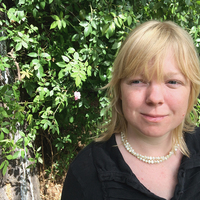Sandra Boss - Profile on Academia.edu (original) (raw)

Related Authors
Uploads
Papers by Sandra Boss
Tuning the Ear, 2018
This thesis sets out to propose a new attention towards the term hearing by exploring the technol... more This thesis sets out to propose a new attention towards the term hearing by exploring the technologies which historically have been used to diagnose, normalize and even optimize the ear. By attending to both the discursive frames and the operative means of selected audiological instruments, it exposes how technology tunes the ear, that is how technology lets us hear and how technology frames conceptions of hearing.
The research project departs from the construction of three sound works that stage an obsolete audiometer, a row of imaginary sound therapy instruments and a set of reconstructed hearing horns within an aesthetic setting. These sound works propose an alternative methodology for reaching conceptualizations of hearing, where the act of doing, of entering into a practical dialogue with a specific material, forms a way of thinking. As this approach has strong ties to the phenomenological research methodology of Martin Heidegger and Maurice Merleau-Ponty, but also to contemporary research methodologies such as media archaeology and object-oriented ontology, the research project evolves as a tuning between manifold methodologies and theoretical positions, which creates different entrances for exploring the history, the epistemic claims and the auditory attention connected to the act of hearing. The kaleidoscopic perspective on the audiological instruments enables for a presentation of hearing beyond the passive position it has partaken within especially the field of sound studies and the field of audiology, and it propose hearing as a varied, malleable and indeed complex perceptual auditory state.
Tuning the Ear, 2018
This thesis sets out to propose a new attention towards the term hearing by exploring the technol... more This thesis sets out to propose a new attention towards the term hearing by exploring the technologies which historically have been used to diagnose, normalize and even optimize the ear. By attending to both the discursive frames and the operative means of selected audiological instruments, it exposes how technology tunes the ear, that is how technology lets us hear and how technology frames conceptions of hearing.
The research project departs from the construction of three sound works that stage an obsolete audiometer, a row of imaginary sound therapy instruments and a set of reconstructed hearing horns within an aesthetic setting. These sound works propose an alternative methodology for reaching conceptualizations of hearing, where the act of doing, of entering into a practical dialogue with a specific material, forms a way of thinking. As this approach has strong ties to the phenomenological research methodology of Martin Heidegger and Maurice Merleau-Ponty, but also to contemporary research methodologies such as media archaeology and object-oriented ontology, the research project evolves as a tuning between manifold methodologies and theoretical positions, which creates different entrances for exploring the history, the epistemic claims and the auditory attention connected to the act of hearing. The kaleidoscopic perspective on the audiological instruments enables for a presentation of hearing beyond the passive position it has partaken within especially the field of sound studies and the field of audiology, and it propose hearing as a varied, malleable and indeed complex perceptual auditory state.








